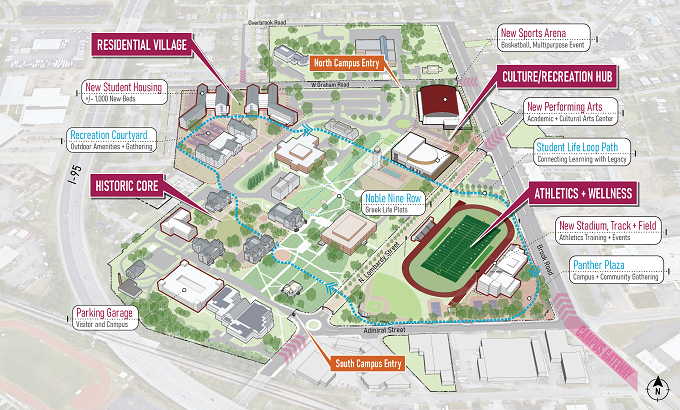
A new campus master plan for Virginia Union University shows new residential buildings and other facilities planned over the next 10 years. (Images courtesy Hanbury)
As it enters its 159th year, Virginia Union University is plotting its future with a new master plan that calls for half a billion dollars’ worth of investment in and around its campus in Richmond’s Northside.
VUU’s Board of Trustees recently endorsed the advancement of the 10-year plan that envisions a new chapter for Richmond’s resident HBCU as a cultural anchor and economic driver for that area and the greater Richmond community.
While largely conceptual and subject to refinement, the campus master plan provides a picture of planned improvements through 2032, starting with new student housing buildings to create a “residential village” on campus, and new facilities to follow that include an athletics and wellness center, a performing arts center and a sports arena.
VUU President Hakim Lucas said the plan represents $500 million in new development and investment that he expects will capitalize on development interest in the area and present opportunities for public-private collaborations with developers, investors and city government.
“When we look at everything that’s happening in Richmond, particularly the crescendo-ing of the Scott’s Addition developments … the question becomes not just about where will people work and live in Richmond, but how do you also live, learn and begin to love Richmond and what will it be known for,” Lucas said.
Describing the adjacent Chamberlayne Industrial Center corridor as one of the last underdeveloped areas in the city, Lucas said VUU’s plan presents an opportunity to help drive and define an identity for the area, which he considers an unnamed hill worthy of mention among Richmond’s famed seven hills.
Noting that the area was once called Sheep Hill and owned by Nathaniel Bacon (of Bacon’s Rebellion fame), Lucas said: “As the oldest African-American-owned, continuously run nonprofit, and as an anchor institution for this side of Northside, we have what we feel is a historic responsibility to try to drive the economic community development of this side of town.
“For us, the question is how do we transform this space again into a vibrant, living-learning-working, middle-class neighborhood that represents the best of Richmond, and not just a hedge fund-owned, sparsely curated industrial park,” he said.
Beyond the 81 acres within VUU’s fences that make up the campus proper, the university also includes surrounding properties that it either controls or hopes to in the future, bringing VUU’s overall footprint to 100 acres, Lucas said.
In the works for several years, the plan was developed with design firm Hanbury, which VUU engaged in 2019. Other firms involved include EDSA, which provided landscape planning; VHB, which handled transportation planning; and Affiliated Engineers, which handled engineering and systems planning.
The group solicited input from university stakeholders, including students, faculty and alumni, and is now presenting the plan to the broader community. Feedback from community stakeholders could further shape and refine the plan, which Hanbury’s Elizabeth Morgan noted is a long-term vision.
“This is obviously not going to happen in a day or a year. This is a long-term plan that’s going to take a lot of collaboration and partnership and vision to bring it to fruition, but in the near term, look at how we can right-size and reshuffle some of the current spaces, reinvest in some of the current facilities on campus and look for opportunities as we look at scaling up enrollment.”
Totaling 2,000 students today, VUU anticipates continued student growth, Lucas said, and wants to accommodate that with the first part of the plan: a new-construction residential village that would add 1,200 beds and provide new amenities for students.
“We’ve grown to 2,000 students, our largest enrollment in our history, and we know that we can’t have students still living in buildings built in 1899,” he said.
As shown on a conceptual site map in the plan, the new residential buildings would fill the northwest corner of campus along Graham Road, replacing MacVicar Hall and an existing parking lot behind the Claude G. Perkins Living and Learning Center. A recreational courtyard also would be added behind the center.
Lucas said the goal is to complete the residential village by 2027, along with reinvestments in VUU’s “Noble Nine” buildings – the nine granite structures built in 1899 that made up the original campus.
Among them is the Industrial Hall building, which is undergoing a restoration to become an art gallery and museum for the university. Lucas said the restored building will be called the William and Pamela Royall Fine Arts Building, named for the Richmond couple behind higher ed tech firm EAB who both have served on VUU’s Board of Trustees. (Bill Royall died in 2020.)
Between that building and VUU’s library at the southern end of campus, a parking garage is planned to replace an existing surface lot. Farther east, across Lombardy Street and across from the main campus, an innovation center is planned along the south side of Admiral Street, where VUU owns one building and expects two others to become available with anticipated relocations of RRHA and Richmond Parks & Recreation offices.
The property at 1320 School St., bought last year by a Charlottesville investor, is eyed as a potential location for a lab school. Lucas said he hopes to enter into a partnership with the property’s owner for that project.
Perhaps the biggest and shiniest parts of the plan are anticipated in its later stages: an athletics and wellness facility at Admiral Street and Brook Road, and a performing arts center and a sports arena planned near Brook and Lombardy.
The athletics center would include a civic plaza that Morgan described as a “front door” for campus. It also would involve a slight relocation of Hovey Field to fit a track around the football field.
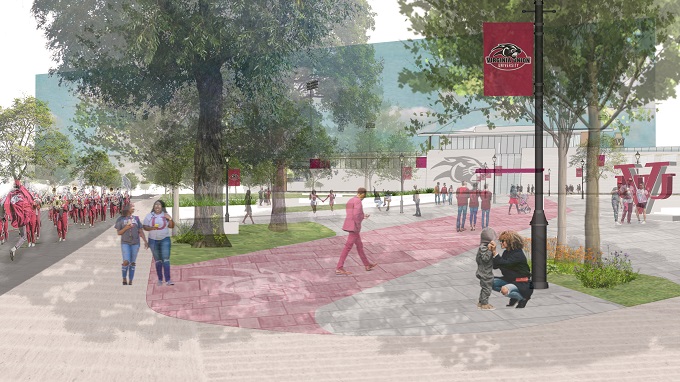
A civic plaza planned at Brook Road and Admiral Street would lead to the athletics and wellness center and serve as a “front door” for the campus.
The sports arena is shown on the plan as filling open space along Brook at the north campus entrance off Graham Road, while the performing arts center is shown to the south, fronting Lombardy in the vicinity of VUU’s Belgian Building and its illuminable logo-adorned bell tower.
The plan shows the arts center building in place of the gymnasium part of the Belgian Building complex, all of which is under a state preservation easement. University officials stressed that the plan is one artist’s conceptual illustration and that actual locations of buildings are to be determined.
“This is a concept, this is a plan, and there’s a huge amount of engagement that’s going to happen over the next several months,” said Grant Neely, VUU’s vice president of university relations.
Morgan said the new facilities would further integrate the university with the community. She described the design approach as “really thinking about the importance of these campus edges and thresholds and how we can literally and aspirationally take down those fences and make Union a place that continues to be an anchor of this North Richmond neighborhood.”
Lucas said he hopes that the plan excites potential partners, both in the private and public sectors, that could collaborate with VUU to see the projects through.
“We’re going to need partners,” he said. “We’re talking about a $500 million development plan. Our board has authorized it, but the point for us is to really lay this out in a way that excites public-private partners to come and be a part of this vibrancy.”
Meanwhile, Lucas said VUU is progressing with its plan for a mixed-use development to replace the former Budget Inn of Richmond motel at Brook and Lombardy. He said demolition is anticipated in the first quarter of this year and a 12-month construction project would then get underway, with completion expected in 2025.
VUU also is planning a hotel near Carver at its C.D. King Hall property at Lombardy and Leigh streets. Lucas said that project, which would anchor the university’s hospitality management program, remains active.

A new campus master plan for Virginia Union University shows new residential buildings and other facilities planned over the next 10 years. (Images courtesy Hanbury)
As it enters its 159th year, Virginia Union University is plotting its future with a new master plan that calls for half a billion dollars’ worth of investment in and around its campus in Richmond’s Northside.
VUU’s Board of Trustees recently endorsed the advancement of the 10-year plan that envisions a new chapter for Richmond’s resident HBCU as a cultural anchor and economic driver for that area and the greater Richmond community.
While largely conceptual and subject to refinement, the campus master plan provides a picture of planned improvements through 2032, starting with new student housing buildings to create a “residential village” on campus, and new facilities to follow that include an athletics and wellness center, a performing arts center and a sports arena.
VUU President Hakim Lucas said the plan represents $500 million in new development and investment that he expects will capitalize on development interest in the area and present opportunities for public-private collaborations with developers, investors and city government.
“When we look at everything that’s happening in Richmond, particularly the crescendo-ing of the Scott’s Addition developments … the question becomes not just about where will people work and live in Richmond, but how do you also live, learn and begin to love Richmond and what will it be known for,” Lucas said.
Describing the adjacent Chamberlayne Industrial Center corridor as one of the last underdeveloped areas in the city, Lucas said VUU’s plan presents an opportunity to help drive and define an identity for the area, which he considers an unnamed hill worthy of mention among Richmond’s famed seven hills.
Noting that the area was once called Sheep Hill and owned by Nathaniel Bacon (of Bacon’s Rebellion fame), Lucas said: “As the oldest African-American-owned, continuously run nonprofit, and as an anchor institution for this side of Northside, we have what we feel is a historic responsibility to try to drive the economic community development of this side of town.
“For us, the question is how do we transform this space again into a vibrant, living-learning-working, middle-class neighborhood that represents the best of Richmond, and not just a hedge fund-owned, sparsely curated industrial park,” he said.
Beyond the 81 acres within VUU’s fences that make up the campus proper, the university also includes surrounding properties that it either controls or hopes to in the future, bringing VUU’s overall footprint to 100 acres, Lucas said.
In the works for several years, the plan was developed with design firm Hanbury, which VUU engaged in 2019. Other firms involved include EDSA, which provided landscape planning; VHB, which handled transportation planning; and Affiliated Engineers, which handled engineering and systems planning.
The group solicited input from university stakeholders, including students, faculty and alumni, and is now presenting the plan to the broader community. Feedback from community stakeholders could further shape and refine the plan, which Hanbury’s Elizabeth Morgan noted is a long-term vision.
“This is obviously not going to happen in a day or a year. This is a long-term plan that’s going to take a lot of collaboration and partnership and vision to bring it to fruition, but in the near term, look at how we can right-size and reshuffle some of the current spaces, reinvest in some of the current facilities on campus and look for opportunities as we look at scaling up enrollment.”
Totaling 2,000 students today, VUU anticipates continued student growth, Lucas said, and wants to accommodate that with the first part of the plan: a new-construction residential village that would add 1,200 beds and provide new amenities for students.
“We’ve grown to 2,000 students, our largest enrollment in our history, and we know that we can’t have students still living in buildings built in 1899,” he said.
As shown on a conceptual site map in the plan, the new residential buildings would fill the northwest corner of campus along Graham Road, replacing MacVicar Hall and an existing parking lot behind the Claude G. Perkins Living and Learning Center. A recreational courtyard also would be added behind the center.
Lucas said the goal is to complete the residential village by 2027, along with reinvestments in VUU’s “Noble Nine” buildings – the nine granite structures built in 1899 that made up the original campus.
Among them is the Industrial Hall building, which is undergoing a restoration to become an art gallery and museum for the university. Lucas said the restored building will be called the William and Pamela Royall Fine Arts Building, named for the Richmond couple behind higher ed tech firm EAB who both have served on VUU’s Board of Trustees. (Bill Royall died in 2020.)
Between that building and VUU’s library at the southern end of campus, a parking garage is planned to replace an existing surface lot. Farther east, across Lombardy Street and across from the main campus, an innovation center is planned along the south side of Admiral Street, where VUU owns one building and expects two others to become available with anticipated relocations of RRHA and Richmond Parks & Recreation offices.
The property at 1320 School St., bought last year by a Charlottesville investor, is eyed as a potential location for a lab school. Lucas said he hopes to enter into a partnership with the property’s owner for that project.
Perhaps the biggest and shiniest parts of the plan are anticipated in its later stages: an athletics and wellness facility at Admiral Street and Brook Road, and a performing arts center and a sports arena planned near Brook and Lombardy.
The athletics center would include a civic plaza that Morgan described as a “front door” for campus. It also would involve a slight relocation of Hovey Field to fit a track around the football field.

A civic plaza planned at Brook Road and Admiral Street would lead to the athletics and wellness center and serve as a “front door” for the campus.
The sports arena is shown on the plan as filling open space along Brook at the north campus entrance off Graham Road, while the performing arts center is shown to the south, fronting Lombardy in the vicinity of VUU’s Belgian Building and its illuminable logo-adorned bell tower.
The plan shows the arts center building in place of the gymnasium part of the Belgian Building complex, all of which is under a state preservation easement. University officials stressed that the plan is one artist’s conceptual illustration and that actual locations of buildings are to be determined.
“This is a concept, this is a plan, and there’s a huge amount of engagement that’s going to happen over the next several months,” said Grant Neely, VUU’s vice president of university relations.
Morgan said the new facilities would further integrate the university with the community. She described the design approach as “really thinking about the importance of these campus edges and thresholds and how we can literally and aspirationally take down those fences and make Union a place that continues to be an anchor of this North Richmond neighborhood.”
Lucas said he hopes that the plan excites potential partners, both in the private and public sectors, that could collaborate with VUU to see the projects through.
“We’re going to need partners,” he said. “We’re talking about a $500 million development plan. Our board has authorized it, but the point for us is to really lay this out in a way that excites public-private partners to come and be a part of this vibrancy.”
Meanwhile, Lucas said VUU is progressing with its plan for a mixed-use development to replace the former Budget Inn of Richmond motel at Brook and Lombardy. He said demolition is anticipated in the first quarter of this year and a 12-month construction project would then get underway, with completion expected in 2025.
VUU also is planning a hotel near Carver at its C.D. King Hall property at Lombardy and Leigh streets. Lucas said that project, which would anchor the university’s hospitality management program, remains active.

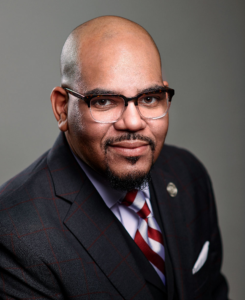
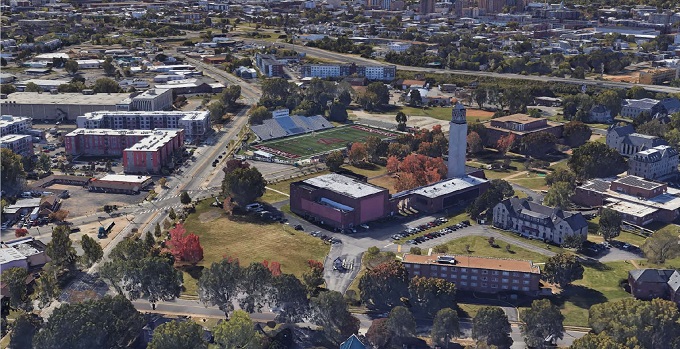
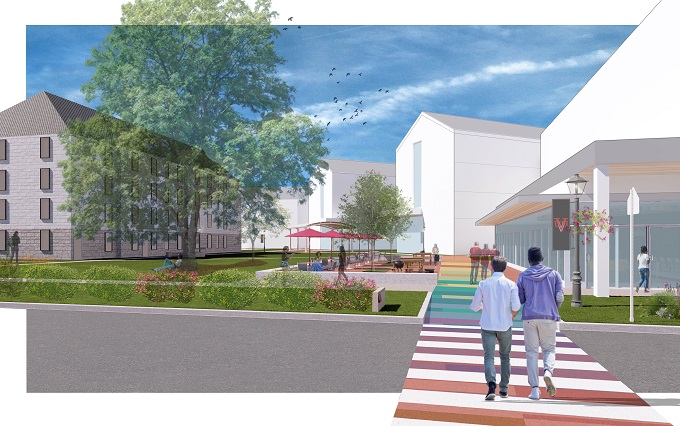


At a time when fewer young people are choosing to go to college and more and more things are being done remotely, why are VUU and VCU embarking on these massive brick-and-mortar projects?
Why indeed at VUU that is got a MAJOR warning in December and has 12 months to get its financial house in order. SACSCOC which accredits them and warned them that for not meeting it goals especially on finance put VUU on probation Dec. 3. They gave the school a year to meet the financial standards or face the consequences. Probation is the final step before accreditation is removed. You loose accreditation, you loose access to federal loans and grant. You CLOSE! Why are the pending money on future project planning when they are on probation.
I understnd that people don’t want to hear it, but huge investments in brick and mortar assets for higher education is like building more Blockbuster stores.
I think this “Plan” is mostly aspirational — if someone wants to step up and fund it, they’ll be happy to take spend the money.
Meanwhile, yes, demographics and students finally waking up to be good customers of education is hurting enrollment at many schools that don’t have lots of applicants per spot.
This is wonderful news! Hopefully, VUU can tap into the money that was misdirected away from HBCUs like VUU.
In 2019, President Trump signed a bipartisan bill directing $255Million per year to HBCUs.
Incorrect. The $255 Million is not for HBCUs, its for all minority serving colleges. Of that $255 million, only $85 million was slated for black colleges. I doubt VUU got any consideration since their president was one of the few black college presidents who would not meet with Trump.
And whose fault was that?
Yeah, this college President seems a little chauvanistic…VSU’s President seems to stick to education and not point fingers.
??? It’s a private college not a ward of the State.
I would be more impressed if the Uni shifted or added a Trade School or Technical Center. The American College of Building Arts in Charlestown seems to be doing rather well and providing a bright future for its students.
I’d be more impressed if VCU or University of Richmond added a trade school or technical center.
What specific trade or technical field do you think would be advantageous for the Richmond area?
All of them, especially construction.
Yeah, that’s a really great school. Unfortunately, schools like that are very rare, but that is good for the graduates!!!
Meanwhile, you can get a degree in some kind of Anthropology just about everywhere in the USA…
I imagine this campus being updated every time I’ve passed it on 95. Great exciting to hear. That whole has potential to extend from the city
Yeah, I was really happy to see them working on that very historic building on their campus. I think it was the original structure?
Funny how this guy says “we can’t house our students in buildings that were built in 1899”. Maybe HE can’t, but colleges like Dartmouth and Rennselaer, who are having much less trouble staying afloat, have no trouble housing students in dorms built long before 1899 —- the dorm rooms are tiny, the halls narrow, but they still use them because students are actually excited to be there and learn and know how many others wanted their place in the tiny old residence halls.
https://sites.dartmouth.edu/deardartmouth/2020/05/23/an-ode-to-my-river-room/
That black middle class neighborhood is no longer there. White people have taken over the entire area.